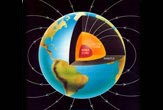All Earth's Electricity Mustered to Destroy an Aluminum Can

At a government test site in Nevada last week, scientists generated a brief electrical pulse four times as powerful as all the electricity on Earth.
It was all over in a few millionths of a second.
And you should have seen the aluminum can.
The 650-ton Atlas Pulsed Power Facility discharged nearly 19 million amperes through a liner, described as an aluminum shell the size of a tuna can. You might expect it would have exploded. Not exactly.
The official line: "The current caused the liner to implode at extreme speeds, with unrivaled symmetry, precision and reproducibility."
That means the event went off as planned. And that's important, because the device is meant to eventually help scientists better understand what happens in a nuclear weapons explosion (right ... you might have hoped they had a handle on that one).
"Such detailed data is needed to validate the sophisticated computer codes upon which scientists rely to certify U.S. nuclear weapons in the absence of underground nuclear testing," officials with the National Nuclear Security Administration said in a statement.
Get the world’s most fascinating discoveries delivered straight to your inbox.
The Atlas machine is a sleeping giant if there ever was one. It stores electrical energy slowly, then releases it all at once.
The rather overmatched can was accelerated in an instant to 27,000 mph, roughly the velocity needed to escape Earth's gravity. The pressure in there was similar to that at the center of the Earth, where iron goes liquid.
The Atlas project began in 1993. The machine was built at the Los Alamos National Laboratory and then moved to the Nevada Test Site.
It cost $48 million to build and $20.4 million to move. Annual operating costs run $6 million. Each experiment , like destroying an aluminum can, tacks on an additional $1 million.
- Top 10 Ways to Destroy Earth
- Palmtop Nuclear Fusion Device Invented
- Natural Nuclear Reaction Powered Ancient Geyser
- The World's Smallest Motor
Robert is an independent health and science journalist and writer based in Phoenix, Arizona. He is a former editor-in-chief of Live Science with over 20 years of experience as a reporter and editor. He has worked on websites such as Space.com and Tom's Guide, and is a contributor on Medium, covering how we age and how to optimize the mind and body through time. He has a journalism degree from Humboldt State University in California.



